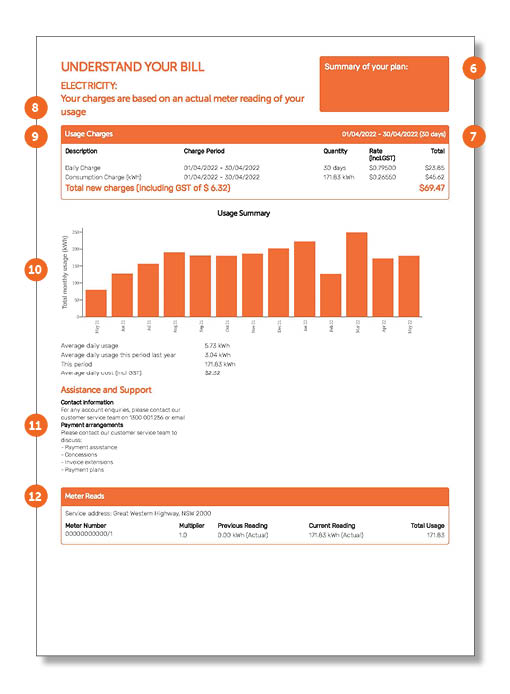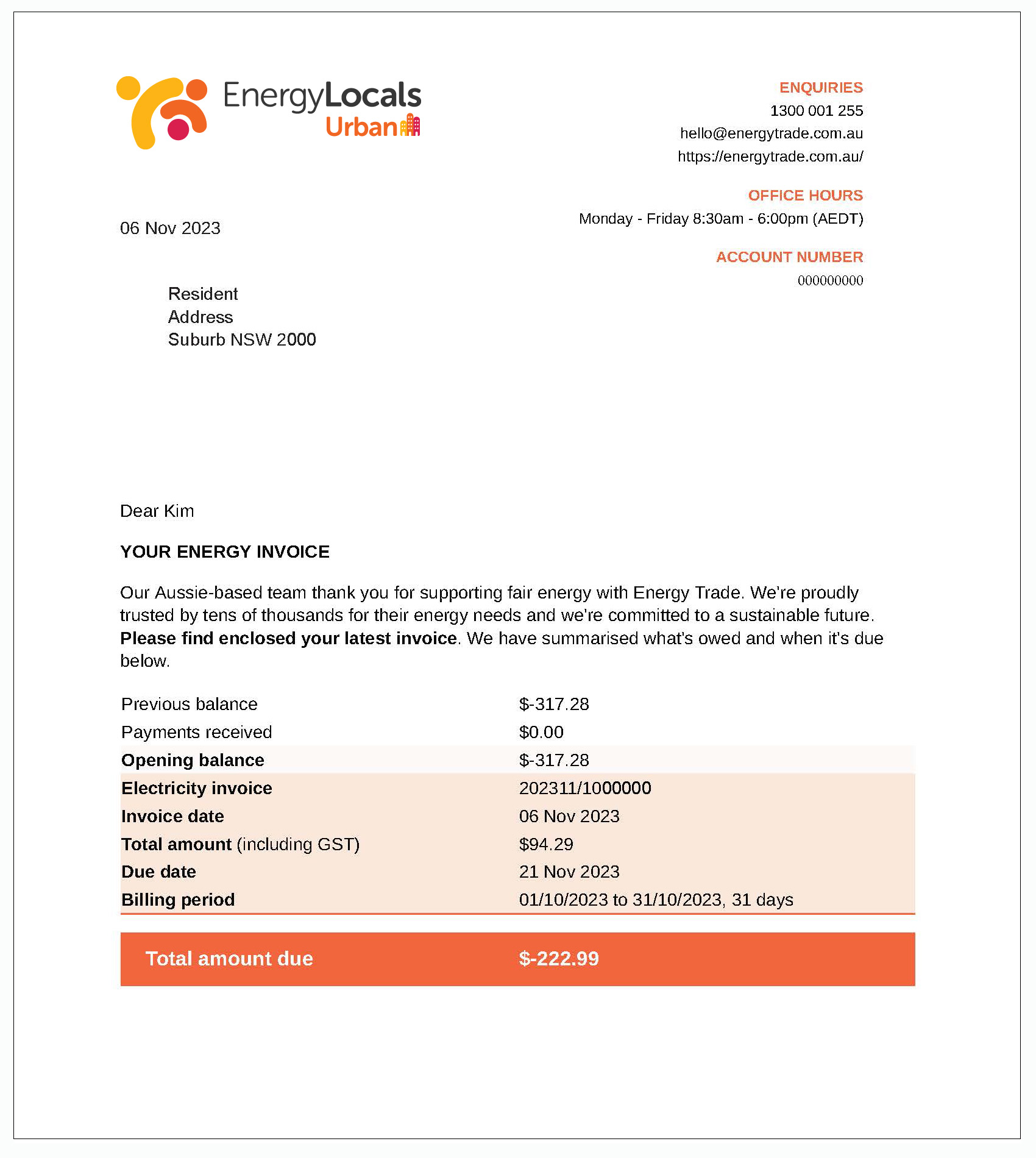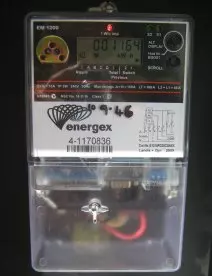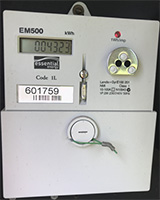
Sign up today
Make the switch to cheaper, cleaner, fairer power. Discover your prices.
My Account
Track your usage and spend, pay your bill, tell us you’re moving, and more.
Welcome to your new home! It’s time to get you all set up with your utilities, and I’m here to guide you through a super easy step to make that happen. First things first, you’ll need to connect your property by completing the simple process at: https://urban.energylocals.com.au/movein
Prefer to talk to someone? No problem! Our Australian-based support team is just a phone call away at 1300 001 255. They’re available from 8:30am to 6:00pm Monday to Friday AEST and would love to help you out.
We’ll then take care of connecting your services. And to make you feel officially part of the Energy Locals Urban community, you’ll receive a Welcome email from us.
A technician will swing by to connect your electricity. Most of the time, they’ll only need to access the meter room, so there’s no need for you to be home.
However, we do have a small favor to ask: please turn off your main electrical switch before you head out. This switch is usually found in a recessed box – you might know it as your ‘fuse’ or circuit breaker box. You’ll often find it tucked away behind or above the fridge, in a bedroom wardrobe, behind a bedroom door, or in the laundry area.
Turning off the main switch means your lights won’t work, which is a good check to ensure it’s actually off. But remember, with no lights, it’ll be dark, so do keep a torch or another light source handy to navigate safely. This simple step ensures a smooth setup for you and our technician.
Thanks for helping us help you, and welcome to the community!
First, make sure you’ve signed up at https://urban.energylocals.com.au/movein.
If possible, try to sign up at least one day before you move in. This little step can help you snag the lowest connection fee. We understand things can be a bit last-minute, though, so we’re also set to connect you on the same day you move in (as long as it’s Monday-Friday before 6pm). Just keep in mind, the fees might vary based on when you make the call.
If you sign up on a weekend or after 6pm on a Friday, we’ll do our best to have you connected by the next business day. We’re unable to schedule connections on weekends or public holidays.
While we aim to get you connected as swiftly as possible, the exact time can vary based on your location and our technicians’ schedule for the day.
Here’s a simple check you can do to test if you’re connected:
You can pay your bill quickly and easily through My Account and our Payment Portal.
We recommend setting up Direct Debit through your online account. Your payments will take care of themselves, giving you one less thing to worry about.

1. Your account details
This is where you’ll find your account number, National Meter Identifier (NMI), invoice number, and issue date. Mention these details if contact us with any queries about your bill.
2. Who to call for assistance
The best contact numbers for faults, emergencies, or queries for our Aussie-based team.
3. What to pay and when
This section tells you what you need to pay for the power you’ve used and by when. If you have Direct Debit, we’ll automatically deduct the amount on the due date.
If your balance is lucky enough to include “CR,” it means you’re in credit and don’t need to pay.
4. Could you save money on another plan?
We’ll regularly let you know if we have other plans available that you may be better off on based on your usage history.
If you’re already on the best plan for you we’ll also let you know.
Currently available in NSW, VIC, SA & QLD.
5. How you can pay
We offer several convenient ways to pay your bill. We recommend setting up Direct Debit through your online account so that you receive lower rates and avoid any late fees that may be applicable.

6. Summary of your plan
This is the plan you’re currently on.
7. Billing period
The period for which your usage is calculated.
8. How your usage has been calculated
Actual read means we have accurate usage data for the period.
An estimated read occurs when the metering company has had trouble getting actual reads from your meter, often because it was not able to be accessed. The estimated read will be based on previous usage data.
A Substitute read happens when there’s missing data, sometimes only a thirty-minute interval, that may be caused by a disruption to your meter communications.
9. Your charges and credits
Supply Charge: This is the daily charge that we collect for the network company as well as the cost of metering.
Usage Charges (e.g., anytime, peak, off-peak, demand): These charges are calculated based on the number of kilowatt hours you’ve used, multiplied by the applicable rate.
10. Compare your usage
See how your average energy usage changes and how it stacks up against other households.
11. Other available services
Here, you can find information about other services we offer, such as concession eligibility, moving to a different property, or support for payment difficulties.
12. Meter read information
This section provides information about the meter readings used to calculate your energy bill for the billing period.

Previous balance
This is what you owed after your last bill.
Payments received
This shows the payments you’ve made from your last bill towards your previous balance.
Opening balance
The remaining amount from your last bill that still needs to be paid.
Total amount
The new charges for your energy usage during this billing period.
Total amount due
This is the grand total of what you need to pay – it’s the sum of what’s on this bill and what you still owe from before.
Seeing your bill take an unexpected jump can raise an eyebrow or two, but there’s usually a pretty straightforward reason behind it. Things like the change in seasons can really influence how much energy we use—think cranking up the heat during those chilly winter months or keeping cool with the AC in summer.
If your home’s been a bit busier than usual, with extra guests or maybe you’ve been hanging out more at home, this can also bump up your energy use. And let’s not forget about that shiny new gadget or appliance you’ve just started using; those can sometimes be more power-hungry than you’d expect.
But no worries, we’ve got your back! You can keep a close eye on your energy use and even set up alerts through My Account, so you aren’t caught off guard. Plus we’ve included our top energy-saving tips lower on this page.
Getting a bill based on an estimated reading is pretty common and nothing to stress about. It just means we’ve had to calculate your energy usage based on your past consumption. This usually happens when we can’t get an actual reading from your meter, maybe because it’s a basic meter that needs someone to check it manually, and we couldn’t get the data in time.
If your bill is estimated you don’t need to do anything. But if you’d rather have it reflect your actual usage, you’re more than welcome to send us a self-read. It’s a straightforward process:
1. Check if your estimate is accurate
To determine if you would like to submit a self-meter read for a revised invoice, how’s how you can safely read your meter and compare:
Dial Meter
Read each dial from left to right and record the numbers that are displaying If the pointer is between two numbers, record the lower number.
Clock Face meters
These have 4-5 clock face dials that record the customer’s consumption.
The reading on the example meter below is 18453.
Digital meters
Type 1

The reading for this meter is 80842
Type 2

The reading for this meter is 001164
Type 5

The meter reading for this meter is 004323
Smart meter
Model mk7a – One phase, two element
*note that some meters may not have all these registers
Model MK7C
Model MK10D
2. Send us your self-read
Once you’ve read your meter and would like a revised invoice with accurate readings, please:
For those buildings where we take care of the hot water supply, your charges are straightforward and fair – you only pay for the hot water you use. So, you can enjoy hot showers, knowing your bill reflects your own usage, and not a drop more.
Depending on your specific situation, you might be in line for a rebate that could help lower your energy expenses.
To see if you’re eligible, just head over to our energy concessions page at https://energylocals.com.au/urban-energy-concessions/. There, you’ll find all the info you need to understand the types of rebates available and how to apply for them. It’s a simple step that could make a big difference in your energy bills.
When it’s time to say goodbye to your current place, just let us know when you’re moving out. We’ll take care of scheduling your disconnection for the day after you leave.
If you’re moving into a residential property, we’ve got great news. Energy Locals can light up your new home too, allowing you to continue enjoying a fair energy deal and award-winning Aussie support. Schedule your connection in just a few minutes.
If you’re moving into another property also within a community energy network, we can only supply your energy if your new building is also supplied by Energy Locals Urban.
If you haven’t yet created an account with us you just need to visit https://urban.energylocals.com.au/movein or call our Aussie-based on 1300 001 255 8.30am to 6pm Monday to Friday.
If have joined us next step is to check your circuit breakers or if there is an outage.
If power is out across your building or neighbourhood, unfortunately, it’s out of our hands as they’re often caused by storms, maintenance, or wires failing. But don’t worry, we’ve got some information to help if your lights go out here: https://energylocals.com.au/outages
In any situation where you’re facing a threat to life or property, such as smoke or fire in your apartment building, it’s crucial to act immediately and call the emergency services on 000. They’re equipped and ready to handle these emergencies, ensuring your safety and that of others around you. Always prioritise calling for help in these critical moments.
Prepare to face the heat without breaking the bank. We’ve curated simple and practical tips to keep you cool and ensure your energy bill stays in check.
Harness the Power of Nature
Did you know that heating and cooling can account for a whopping 40% of your power bill? Instead of immediately resorting to the air-conditioner, embrace the natural cool breeze. Open windows and doors to invite refreshing air into your home. During the day, close blinds and curtains in unused rooms to block out the sun’s heat and maintain a comfortable indoor environment.
Master the Art of Air-Conditioning
Surviving without air-conditioning can be tough, but there’s no need to turn your home into an icebox. Set your air-conditioner to a moderate 25-26 degrees and use timers to run it only when necessary. Rather than leaving it on throughout the night, program it to turn off 15 minutes after your usual bedtime. Smart adjustments equal cool savings!
Fans: Your Energy-Efficient Allies
Upright or ceiling fans are budget-friendly alternatives, consuming less than 10% of the energy required for air-conditioning. Before reaching for the air-con remote, consider using a fan. For an extra cooling effect, create homemade ice packs or keep a spray bottle filled with cool water to mist yourself during the day.
Take the Culinary Adventure Outdoors
Why heat up your kitchen when you can enjoy the summer vibes outdoors? Utilise your barbecue to cook meals, avoiding the need for the oven or stove. This not only saves energy but also enhances the overall summer experience.
Summer Boredom Equals Summer Savings
Whether it’s school holidays or more time spent at home, make energy-saving a family affair. Encourage your kids to turn off lights, take shorter showers, and ensure the TV isn’t left on standby. Small, collective efforts can lead to significant savings.
Vacation Mode: Smart Energy Practices
Planning a vacation? Ensure you’re not wasting energy in your absence. Power down appliances before you leave. If you’re leaving lights on for security reasons, invest in a timer switch to illuminate your home only at specific times each day. This not only contributes to energy savings but also enhances the security of your home.
Stay cool, save big!
